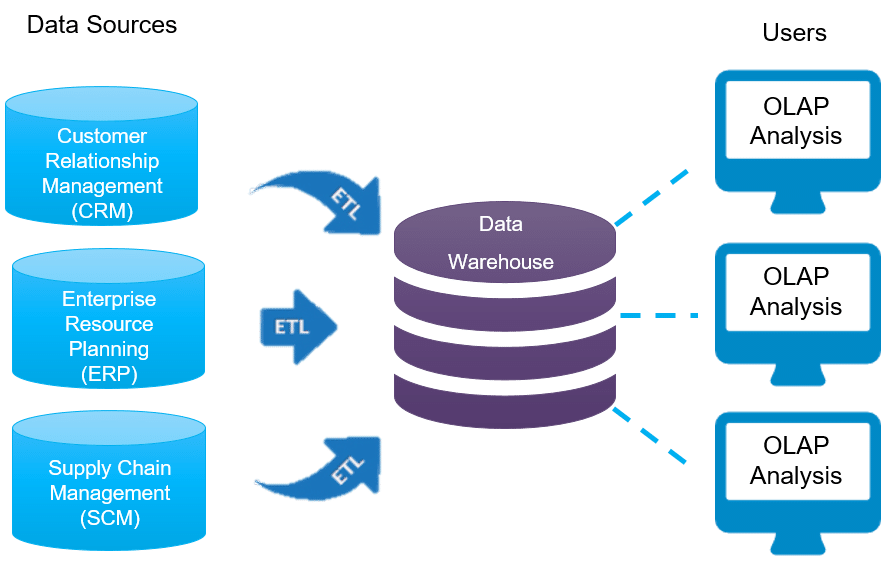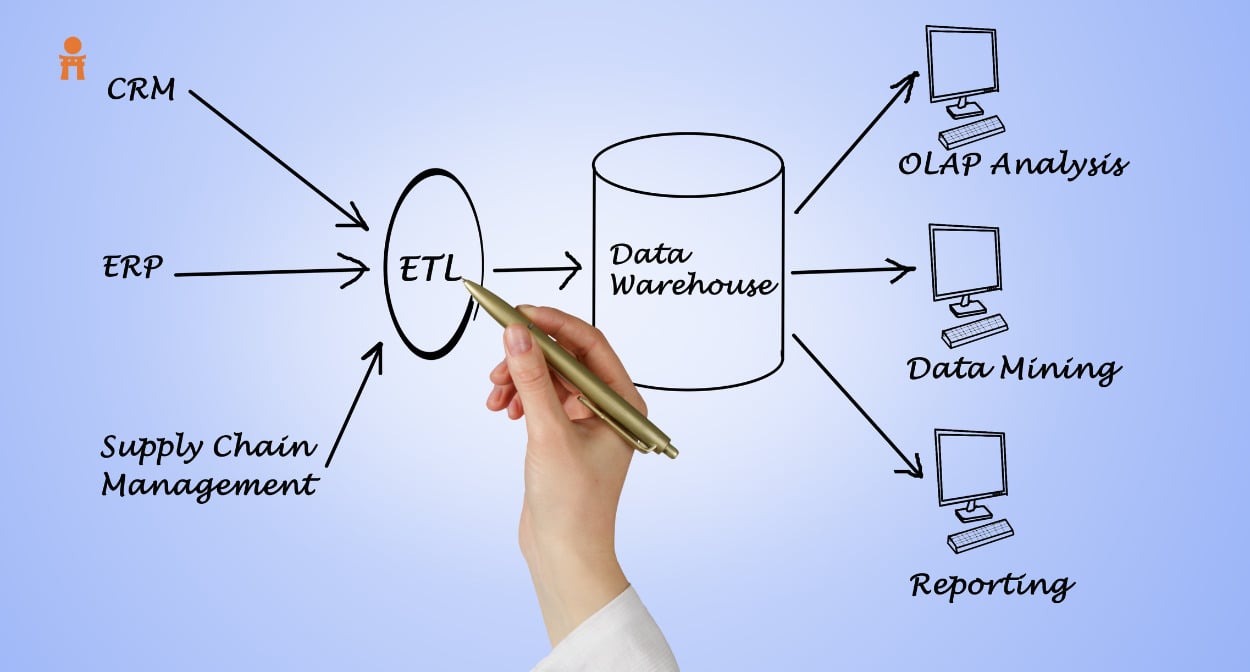The modern digital world is driven by data and its insights. In this era, data storage has become an important part of running a business. When it comes to data, there are two main types of storage methods: data lakes and data warehouses.
In this blog, we will explore the details of each data storage method and take a deeper dive into their comparison. Which one is right for your business? Let’s take a closer look.
What is a Data Lake?
An enormous amount of raw data is stored in its original format in a data lake until it is required for analytics applications. A data lake uses a flat design to store data, typically in files or object storage, as opposed to a traditional data warehouse, which stores data in hierarchical dimensions and tables.
Users now have more options in how they manage, store, and use their data.
Copious amounts of organized, semi-structured, and unstructured data can be stored, processed, and secured using a data lake, a centralized repository. It can process any type of data, regardless of its variety or magnitude, and save it in its original format.
Hadoop systems and data lakes are frequently mentioned together. Data is loaded into the Hadoop Distributed File System (HDFS) and stored on the many computer nodes of a Hadoop cluster in deployments based on the distributed processing architecture.
However, instead of using Hadoop, data lakes are increasingly being constructed using cloud object storage services. Some NoSQL databases are also utilized as platforms for data lakes.
Elements of a Data Lake and Analytics Solution
Organizations should consider a variety of crucial features as they construct data lakes and analytics platforms, including:
1. Data Transfer
Any quantity of data that can arrive in real-time can be imported using data lakes. Data is gathered from many sources and transferred in its original format to the data lake. By using this method, you may speed up the process of defining data structures, schema, and transformations while scaling to any size of data.
2. Securely Store and Catalog Data
Data lakes let you store both relational and non-relational data, including data from social media, IoT (Internet of Things) devices, operational databases, and line-of-business applications. Through data crawling, cataloging, and indexing, they also enable you to know what data is in the lake. To preserve your digital assets, data must lastly be secured.
3. Analytics
Data lakes give various positions in your company, such as data scientists, data developers, and business analysts, access to data using the analytical tools and frameworks of their choice.
This covers commercial products from data warehouses and business intelligence providers as well as open-source frameworks like Apache Hadoop, Apache Spark, and Apache Presto. You can perform analytics with Data Lakes without moving your data to a different analytics system.
Read more about the basics of machine learning
4. Machine Learning
Organizations will be able to use data lakes to generate a variety of insights, such as reporting on historical data and machine learning, where models are created to predict outcomes and provide several recommended actions to obtain the best conclusion.
Insights of Data Warehouse
A data warehouse is a database designed for the analysis of relational data from corporate applications and transactional systems. The results of rapid SQL queries are often utilized for operational reporting and analysis; thus, the data structure and schema are set in advance to optimize for this.

Data warehouses have deep-rooted applications in various industries that use historical data for decision-making, prediction, and statistical analysis. It lists 12 applications of data warehouses across different fields, such as retail, healthcare, banking, and telecommunication.
Highlighting the benefits of using data warehouses, it consolidates all the data from different sources into a single place for effective reporting and analysis.
According to Allied Marketing Research, the global data warehousing market is projected to grow at over 10% CAGR to reach up to $51.18 Billion by 2028, showing the wide applications and usage of data warehouses in different fields.
Data Lakes Compared to Data Warehouses – Two Different Approaches
What a data lake is not also helps to define it. It is different from a data warehouse and is not just storage.

While both data lakes and data warehouses have some potential for storing data, each is tailored for a particular purpose. Consider them complementary tools rather than competitors, as certain businesses may require both.
For example, data warehouses are frequently the best option for the type of repetitive reporting and analysis that is typical in business procedures, such as monthly sales reports, tracking of sales by area, or website traffic.
Users: Data Scientists vs Business Professionals
People who are not used to working with raw data frequently find it challenging to explore data lakes. To comprehend and transform raw, unstructured data for any specific business use, it typically takes a data scientist and specialized tools.
As an alternative, data preparation tools that provide self-service access to the information kept in data lakes are gaining popularity.
Learn about data preprocessing in this blog
Data Structure: Raw vs. Processed
Raw data is information that has not been processed yet. The different structures of raw vs. processed data are the biggest difference between data lakes and data warehouses. Data warehouses hold processed and refined data, whereas data lakes typically retain raw, unprocessed data.
Data lakes therefore often need more storage space than data warehouses. Additionally, unprocessed, raw data is pliable and suitable for machine learning. It may be easily evaluated for any purpose.
However, the risk of all that unstructured data is that, in the absence of adequate data quality and data governance mechanisms, data lakes might occasionally turn into data swamps.
Data warehouses, by storing only processed data, save on pricey storage space by not maintaining data that may never be used. Additionally, processed data can be easily understood by a larger audience.
Accessibility: Flexible vs Secure
Accessibility and usability apply to how data repositories are used as a whole, not only to the data they contain. Data lake architecture lacks structure, making it simple to use and adapt. Additionally, because data lakes have such few restrictions, any updates to the data can be made fast.
The structure of data warehouses is more rigid by design. The fact that data is processed and structured in a way that makes it easier to understand is one of the main advantages of data warehouse architecture. However, because of the restrictions imposed by the structure, manipulating data warehouses can be challenging and expensive.
Purpose: Undetermined vs In-Use
Each piece of data in a data lake has a different function. Raw data enters a data lake, with a specific purpose in mind and occasionally just for storage. This indicates that compared to their counterparts, data lakes have less organization and filtration of data.
Data that has been processed has been used for a particular purpose. Data warehouses only hold processed data; thus, each piece of information has been used within the company. This implies that data that may never be needed is not wasting storage space.
Data Lake vs Data Warehouse: Which is Right for Me?
Businesses frequently require both. Data lakes were developed because of the requirement to utilize big data and take advantage of the unprocessed, granular structured, and unstructured data for machine learning, but data warehouses are still required for business users to use for analytics.
Healthcare: Unstructured Data is Stored in Data Lakes
Although data warehouses in the healthcare sector date back a long time, it has never been effective. Data warehouses are typically not the best model due to the unstructured nature of much of the data in healthcare (physician’s notes, clinical data, etc.) and the requirement for real-time insights.
Combining organized and unstructured data is possible with data lakes, making them a better fit for healthcare organizations.
Learn more about data exploration and visualization in healthcare
Data Lakes for Transportation: Making Forecasts
Making forecasts is one of the key benefits of data lake insight. The prediction ability that results from flexible data in a data lake can have enormous benefits in the transportation business, especially in supply chain management. One such benefit is cost savings gained by looking at data from forms inside the transport pipeline.
Education: Data Lakes Offer Flexible Solutions
The huge importance of data in school reform has just become known in a big way. In addition to assisting failed students in getting back on track, data regarding student grades, attendance, and other factors can also be used to anticipate problems before they arise.
Educational institutions have also benefited from flexible big data solutions by streamlining billing, raising more money, and other things.
The flexibility of data lakes often works best for educational institutions because a lot of this data is large and extremely raw.
Navigate the details of educational data exploration and visualization using Power BI
Finance: The Appeal of Data Warehouses is Widespread
Because it may be organized for access by the entire firm rather than just a data scientist, a data warehouse is frequently the optimal storage strategy in the financial industry as well as other commercial contexts.
Data warehouses have played a significant role in the advancements that big data has made possible for the financial services sector. The only reason a financial services organization would decide against using such a model is because it is less efficient overall but more cost-effective.
Conclusion
A data lake is unique because it holds both relational and non-relational data from social media, IoT devices, and line-of-business applications. When data is captured, its structure or schema is not specified.
As a result, you can keep all your data without meticulous planning or the requirement to anticipate future queries. To find insights, you can analyze your data using a variety of methods, including big data analytics, full-text search, real-time analytics, and machine learning.
To conclude, businesses are updating their data warehouses to include data lakes for more advanced data analysis and tools.
Learn more about the recent updates within the world of data science, AI, and LLMs. Join our Discord channel today!





